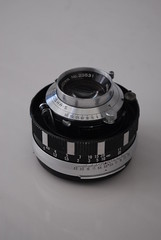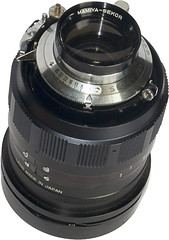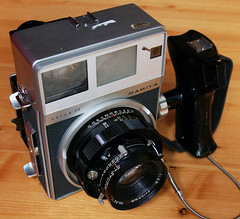Mamiya Press
The Mamiya Press is a medium format rangefinder camera system designed to accept interchangeable backs and lenses. Mamiya made a number of variants to the basic body design, including one model, the 600SE, that was licensed to be marketed under the Polaroid name. The camera body itself is a simple affair, with a single-window combined range- and view-finder that couples to the lens for focusing. It has tripod mounts in both vertical and horizontal positions, a mount for a handgrip for the left hand, and cold shoes on both the body and the handgrip.
Contents
Lens System
The lens system incorporates a breechlock mount unique to the Mamiya Press, and each lens is mounted in a Seikosha leaf shutter. The original (chrome) lens uses a shutter called Seikosha-S, while the updated versions used Seiko #0. Lenses of fixed focal lengths from 50mm to 250mm were produced, all of which covered up to 2x3 film sheets, while the 127mm and 75mm lenses offered the greater coverage necessary for the 2 7/8 x 3 3/4 inch images produced by the Polaroid backs.
Lenses produced were:
- 50mm f/6.3 - 8 elements in 5 groups (Biogon type), 72mm filter, 610g
- 65mm f/6.3 - 4 elements in 4 groups (Topogon type), 350g
- 75mm f/5.6 - 7 elements in 4 groups (Super-Angulon type), 72mm filter, 650g
- 90mm f/3.5 (chrome) - 4 elements in 3 groups (Tessar type), collapsible, 40.5mm filter
- 100mm f/3.5 (chrome) - 4 elements in 3 groups (Tessar type), 40.5mm filter
- 100mm f/3.5 - 4 elements in 3 groups (Tessar type), 55mm filter, collapsible, 480g
- 100mm f/3.5 "E" - 4 elements in 3 groups (Tessar type), 55mm filter, rubber grip, not collapsible, 445g
- 100mm f/2.8 - 6 elements in 4 groups (Biotar type), 72mm filter, 700g
- 127mm f/4.7 - 4 elements in 3 groups (Tessar type), 55mm filter, 470g
- 150mm f/5.6 (chrome) - 4 elements in 3 groups (Tessar type), 40.5mm filter
- 150mm f/5.6 - 4 elements in 3 groups (Tessar type), 55mm filter, 530g
- 250mm f/8 - 6 elements in 4 groups (not rangefinder coupled), 55mm filter, 650g
- 250mm f/5 - 6 elements in 4 groups (Ernostar type), 105mm filter, 1825g
|
|
|
|
Film Backs & Accessories
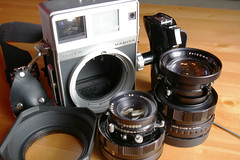
|
| 100 f/3.5 and 100mm f/2.8 lenses image by Erich Z (Image rights) |
Two different types of back exist for the Mamiya Press, the Graflex back, and the Mamiya Back, or G-type and M-types. The backs are incompatible with each other, and Press cameras came in versions for either one back or the other. The Super 23 only accepted Mamiya (M-type) backs. The Mamiya Universal had interchangeable rear adapters - the M adapter and the G adapter. Thus, the Universal was capable of using both Mamiya and Graflex backs, as long as one had the appropriate adapter. The Universal also accepted a Polaroid back; this needed no adapter and attached directly to the main camera body.
Mamiya film backs include a combination 6x4.5-6x6-6x9 back, 6x9, 6x7 and Polaroid packfilm backs. The 6x9 and 6x7 backs were released in three different models. The most common is the model 2 roll film backs. They have a pocket on the back to fit the dark slide. Advancing the film requires releasing the film with a small thumb slider on the back. The film advance requires either two stroke or multiple smaller strokes. The model 3 back, introduced in 1982[1], added a shutter release to the right side. On the base is a release cable that is connected to the lens. Double exposures are prevented as the release will not fire if the darkslide is not removed, unlike the release on the left hand grip. Accessory backs for 2.5 x 3.5 inch (6.5x9cm) sheet film and plates include a right angle focusing back, a magnifying focusing back and a ground glass viewing back. Other accessories include a wire frame sportsfinder, separate finders for the 50mm, 65mm, and 75mm lenses, back spacers and extension tubes.
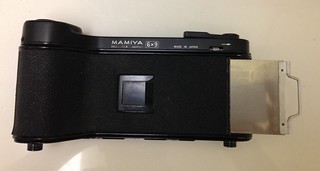
|
| model 2 film back w darkslide partially inserted image by Studioesper (Image rights) |
|
M back
Press back
|
G back
Finder
|
Lens
Misc
|
Iterations
Mamiya Press
| ||
|
The original Mamiya Press system had several minor variations. The first iteration of the camera was introduced in 1960. It lacked brightlines in the finder, came standard with a 90mm f/3.5 lens, and was produced with a M-type back. Later versions were the Press G from 1963, with the Graflex back system, the Press 23, and the Press Standard (a renaming of the original model). Many of these bodies were fitted with rear bellows and locking struts, permitting back tilt or extra focus extension. Foto-Quelle of Germany also sold this camera as the Revue Press.
Mamiya Super 23
This upgraded version was introduced in 1967. It came with a new body and was capable of using roll film and 2x3 sheet film. This added a brightline display in a much larger viewfinder, and parallax-compensated framelines for 100mm, 150mm, and 250mm lenses. The camera was available in silver and black. At this time, leatherette was not used for the covering. Instead a proprietary Mamiya covering is used with a tiny raised letter 'M'. This covering was also used on system parts such as films backs.
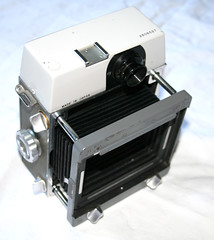
|
| Full extension of bellows back image by Rachel Rayns (Image rights) |
Mamiya Universal

|
| Universal with (P to)M-adapter, M-type roll back and P-type polaroid back. image by joanseda (Image rights) |
Introduced in 1969, this revision uses a body similar to the Super 23 but allowed for use of both Mamiya and Graflex backs, as well as the Land Polaroid back, but eliminated the Super 23's rear bellows device. This was possible, because the native back on the Universal Press (Press back) accepted P-adapters to mount M-Type (Mamiya) or G-Type (Graflex) film holders. A vertical P to M adapter was also available.
When the Mamiya RB67 was released in 1970 a Press back adapter (P-adapter) was available to convert the RB67's back into a press back. This was primarily use to mount Polaroid backs originally designed for the Universal Press. It was also possible to stack additional adapters to mount other backs such as M-type 2 1/4″ x 3 1/4″ film holders.
A similar model was marketed as the Polaroid 600SE, however both the lens mount, and film back mounts, were changed so that neither lenses nor film backs were interchangeable between the Polaroid and Mamiya models. Some 3rd party companies in Japan & the US produced adapters to allow Mamiya Press back accessories to be fitted to the 600SE. The camera was available in silver and black.
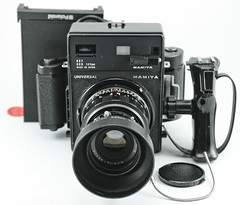
|
| Mamiya Press Universal, with 127mm f4.7 lens and hood 127mm finder mask, 6x9 and instant film backs. image by Zokyo Labs (Image rights) |
Notes
Bibliography
- Asahi Camera (アサヒカメラ) editorial staff. Shōwa 10–40nen kōkoku ni miru kokusan kamera no rekishi (昭和10–40年広告にみる国産カメラの歴史, Japanese camera history as seen in advertisements, 1935–1965). Tokyo: Asahi Shinbunsha, 1994. ISBN 4-02-330312-7. Items 1594–7.
- Kamera no ayumi. Zen nihon shashin renmei sōritsu 50-shūnen kinen (カメラのあゆみ・全日本写真連盟創立五〇周年記念, History of cameras, commemorating the 50th anniversary of the All Japan Association of Photographic Societies). Tokyo: Asahi Shinbunsha, 1976. No ISBN number. P.91.
- McKeown, James M. and Joan C. McKeown's Price Guide to Antique and Classic Cameras, 12th Edition, 2005-2006. USA, Centennial Photo Service, 2004. ISBN 0-931838-40-1 (hardcover). ISBN 0-931838-41-X (softcover). P.645.
- Sugiyama, Kōichi (杉山浩一); Naoi, Hiroaki (直井浩明); Bullock, John R. The Collector's Guide to Japanese Cameras. 国産カメラ図鑑 (Kokusan kamera zukan). Tokyo: Asahi Sonorama, 1985. ISBN 4-257-03187-5. Items 6070–6.
Links
- Mamiya Universal Instruction Manual at Mamiya Leaf.
- Lenses and Depth of Field, also at Mamiya Leaf.
- Comparison of Mamiya Universal and Polaroid 600 SE on moominsean.blogspot.com
- Review of Mamiya Press 23 Standard @ Thorley Photographics by Thorley Bros.
- Mamiya Press, variations and accessories manuals in PDF format at OrphanCameras.com


